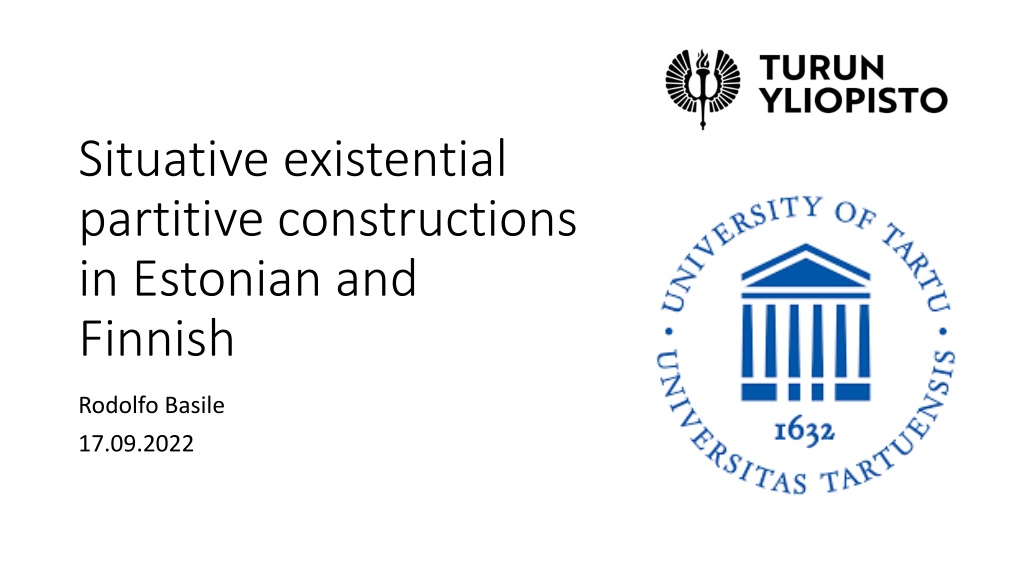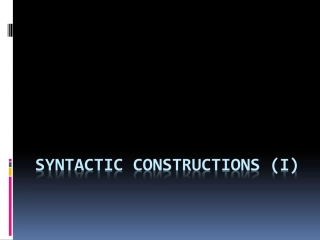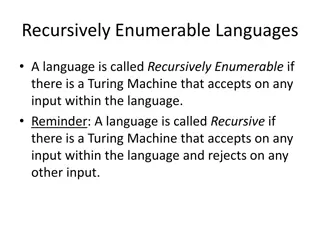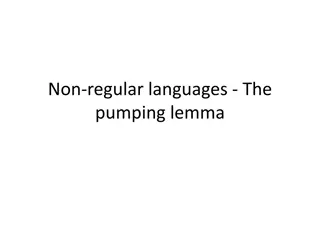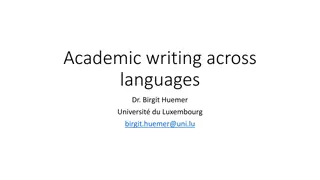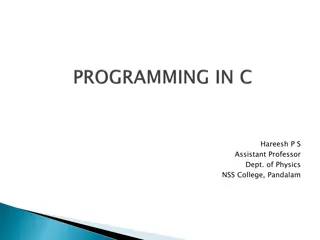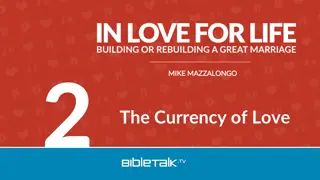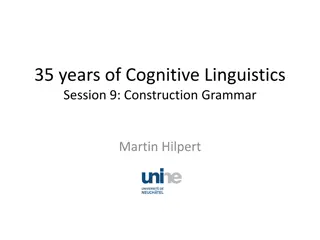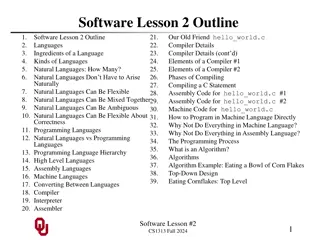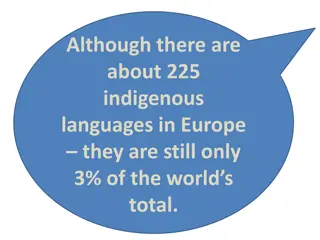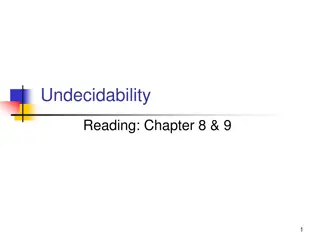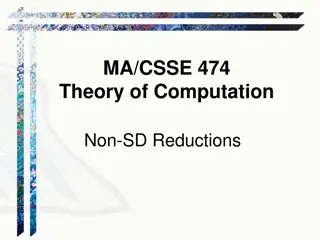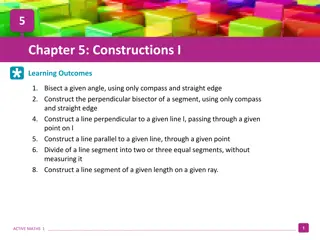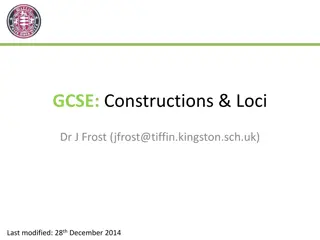Situative and Invenitive Constructions in European Languages
Situative constructions are novel locational strategies in Estonian and Finnish, involving existential or locative forms. Basile (2021, 2022) defines these constructions as predicates with complex aspects, situating referents in concrete or abstract locations. Invenitive constructions, on the other hand, include coreferential and non-coreferential types across various European languages. This linguistic analysis explores how these constructions function in different language contexts.
Download Presentation

Please find below an Image/Link to download the presentation.
The content on the website is provided AS IS for your information and personal use only. It may not be sold, licensed, or shared on other websites without obtaining consent from the author. Download presentation by click this link. If you encounter any issues during the download, it is possible that the publisher has removed the file from their server.
E N D
Presentation Transcript
Situative existential partitive constructions in Estonian and Finnish Rodolfo Basile 17.09.2022
What are situative constructions (situatives)? Novel locational strategies: functionally either existential constructions (given location, new LOCATUM) or locative constructions (given LOCATUM, new location) Defined in Basile (2021, 2022) Predicate has complex lexical aspect (e.g. durative + punctual) Dynamic verb vs static predication Predicate situates referent in concrete/abstract location Loss of prototypical semantic traits Functions like copulas Different from lexical copulas (e.g. German liegen, sitzen )
Situatives in European languages (Basile 2022) Two main groups invenitive constructions (Lat. invenio to find (act.), be found (pass.) Semantic categories SITUATEE and OBSERVER/FINDER Coreferentiality between categories establishes 2 groups 7 types in total evenitive constructions (Lat. evenio to happen ) Only in Albanian
Invenitive constructions non-coreferential type German (West Germanic, Glosbe) Der Bahnhof the station beiden St dten two cities The station is located between these two cities. befindet APPL-find.3SG sich REFL between zwischen diesen these
Invenitive constructions non-coreferential type, present participle Hungarian (Ugric, dictionary) Ez a k nyv nem minden this DET book NEG every This book cannot be found in every library. k nyvt rbantal l-hat- library.INE find-POT-PRP
Invenitive constructions coreferential, reflexive type - usually low volitionality Modern Greek (Glosbe) agapit dear.voc Dear mother, I find myself among wolves. , mit ra, mother.VOC vr sk-o-mai find-1SG-MPAS an mesa between se to wolf.ACC.PL l kous
Invenitive constructions coreferential type, present participle - usually low volitionality Basque (elicited, Urtzi Etxeberria, p.c.) Egoera arraro situation strange I find myself in a strange situation. batean one.INE aurki-tzen find-PRP naiz be.1SG
Evenitive constructions No finder Observer possible Only in Albanian Albanian (Nensi Islami, p.c.) a. Italia Italy Italy is situated in the Mediterranean. b. Ndodh-em/gje-nd-em happen-1SG/find-REFL-1SG keqe bad.ACC I find myself in a bad situation. gje-nd-et/ndodh-et find-REFL-3SG/happen-3SG n in Mesdhe Mediterranean.ACC n in nj a.ACC situat situation.ACC t ADJART .ACC
Situative constructions in Udmurt Reflexive denominal verb from inty- place Udmurt (Permic, Volga-Kama Corpora) antibiotik-jos bydt-o antibiotic-PL tackle-3PL , bakteri-osty bacteria-ACC.PL virus-jos virus-PL - - - inti-ja- k-o place-VBZ-REFL-3PL Antibiotics tackle bacteria, viruses are to be found.
Bridge Between European languages and Uralic Finnic Contamination of existential clauses (Creissels 2014, McNally 2011, Freeze 1992, Hakanen 1972, Huumo 2003) external FINDER Usually only used in 3. person Both with concrete and abstract locations
Partitive subjects in Finnic In Finnish and Estonian, a dedicated partitive grammatical case can express many functions (Huumo 2010, Ser ant 2021) Partitives can alternate with the so-called totalitiivi, a term which includes total objects in genitive or nominative plural, or nominative objects in imperatiive constructions, as well as prototypical subjects in nominative (Larjavaara 2019) The subjecthood of partitives is debatable both semantically and morphosyntactically speaking Associated with existential constructions (Hakanen 1972; Huumo & Lindstr m 2014; Huumo 2003) e-NP (Huumo & Helasvuo 2015; see also Helasvuo 1996, Metslang 2014)
Partitive existential NPs Estonian (Finnic, etTenTen Web 2019) Metsa all leid-u-b forest.GEN under find-REFL-3SG metsamaasik-aid wild.strawberry-PTV.PL There are chanterelles and wild strawberries on the forest floor. kukeseen-i chanterelle-PTV.PL and ja
Partitive existential NPs Finnish (Finnic, Basile & Ivaska 2021) Ero-j-a-kin difference-PL-PTV-ENCL certainly Differences are certainly also found. toki l yt-y-y find-REFL-3SG
Finnish (Basile & Ivaska 2021) Aasiasta l ytyy paljon esimerkke-j Asia.ELA There are many examples to be found in Asia. find.REFL.3SG many example-PTV.PL Mutta my s parkkipaikko-ja but also parking.spot-PTV.PL l ytyy find.REFL.3SG concert.place.GEN konserttipaikan vierest side.ELA But there are parking spots besides the concert venue too.
Basile & Ivaska 2021 Quantitative study on NOM/PART alternation in Finnish 779 sentences containing the verb l yty to be found Corpus KLK (Kansalliskirjaston lehtikokoelma) Mixed effect logistic regression
Agreement and word order Agreement typically influences the choice of partitive in Finnish
References Basile, Rodolfo. 2021. Situative constructions in European languages. In Spevak (ed.), 39 40. Book of Abstracts: 54th Annual Meeting of the Societas Linguistica Europaea. http://www.sle2021.eu/downloads/SLE%202021%20BOOK%20OF%20ABSTRACTS.pdf (Accessed 9- 6-2022). Basile, Rodolfo. Situative Strategies and Constructions in European Languages. OSF, 25 Apr. 2022. Web. Basile, Rodolfo, and Ilmari Ivaska. 2021. L yty -verbin konstruktioiden yhteydess esiintyv subjektin sijanvaihtelu. Eesti ja soome-ugri keeleteaduse ajakiri. Journal of Estonian and Finno-Ugric Linguistics, 12(1), 11-39. Creissels, Denis. 2014. Existential predication in typological perspective. Working Paper. Available online: http://www.deniscreissels.fr/public/Creissels-Exist.Pred.pdf. Freeze, Ray. 1992. Existentials and other locatives. Language 68(3), 553 595. Hakanen, Aimo. 1972. Normaalilause ja eksistentiaalilause. Sananjalka, 14(1), 36-76. Helasvuo, Marja-Liisa. 1996. Ollako Vai Eik Olla-Eksistentiaalilauseen Subjektin Kohtalonkysymys. Viritt j 100 (3): 340 340.
Huumo, Tuomas. 2003. Incremental existence: The world according to the Finnish existential sentence. Huumo, Tuomas. 2010. Nominal aspect, quantity, and time: The case of the Finnish object. Journal of Linguistics, 83-125. Huumo, Tuomas, and Marja-Liisa Helasvuo. 2015. On the Subject of Subject in Finnish. Subjects in Constructions Canonical and Non-Canonical, 13 41. Huumo, Tuomas, and Liina Lindstr m. 2014. Partitives across Constructions: On the Range of Uses of the Finnish and Estonian Partitive Subjects . Partitive Cases and Related Categories 54: 153. Larjavaara, Matti. 2019. Partitiivin Valinta. Suomalaisen Kirjallisuuden Seura McNally, Louise. 2011. Existential sentences. In: Maienborn. Claudia & Von Heusinger, Klaus & Portner, Paul (eds.). Semantics: An International Handbook of Natural Language Meaning. Handb cher zur Sprach- und Kommunikationswissenschaft 33, 2. Berlin: Mouton de Gruyter, 1829 1848. Ser ant, Ilja A. 2021. Typology of partitives. Linguistics, 59(4), 881-947.
